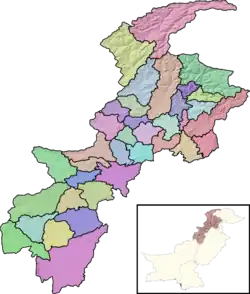Mansehra District
Mansehra District
ضلع مانسہرہ | |
|---|---|
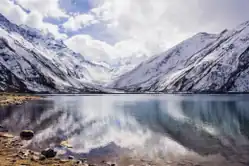 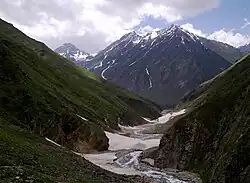 | |
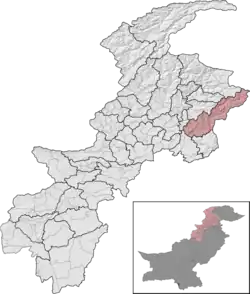 Mansehra District (red) in Khyber Pakhtunkhwa | |
| Country | |
| Province | |
| Division | Hazara |
| Region | Pakhli |
| Headquarters | Mansehra |
| Government | |
| • Type | District administration |
| • Deputy Commissioner | Bilal Shahid Rao (BPS-18 PAS) |
| • District Police Officer | Zahoor Babar Afridi (BPS-19 PSP) |
| Area | |
| 4,579 km2 (1,768 sq mi) | |
| Population | |
| 1,797,177 | |
| • Density | 390/km2 (1,000/sq mi) |
| • Urban | 154,834 (8.62%) |
| • Rural | 1,642,343 |
| Literacy | |
| • Literacy rate |
|
| Time zone | UTC+5 (PST) |
| Area code | 0997 |
| Number of union councils | 59 |
| Number of tehsils | 5[3] |
| Website | mansehra |
Mansehra District (Urdu, Hindko: ضلع مانسہرہ) is a district in the Hazara Division, Khyber Pakhtunkhwa, northern Pakistan. Mansehra city serves as the headquarters of the district. The district has a Hindkowan majority, with a small Pashtun and Kohistani population.
Mansehra was established as an independent district in 1976. It was previously a tehsil within the broader Hazara District.[4] In 1993, a former subdivision of Mansehra, Battagram, was separated as an independent district.[5] Similarly, in 2011, another subdivision of Mansehra, Kala Dhaka, was separated which is now known as Torghar District.
Demographics
| Year | Pop. | ±% p.a. |
|---|---|---|
| 1951 | 260,631 | — |
| 1961 | 373,975 | +3.68% |
| 1972 | 552,842 | +3.62% |
| 1981 | 686,308 | +2.43% |
| 1998 | 978,157 | +2.11% |
| 2017 | 1,555,742 | +2.47% |
| 2023 | 1,797,177 | +2.43% |
| Sources:[6] | ||
As of the 2023 census, Mansehra district has 294,052 households and a population of 1,797,177. The district has a sex ratio of 103.08 males to 100 females and a literacy rate of 63.79%: 75.33% for males and 52.02% for females. 478,985 (26.76% of the surveyed population) are under 10 years of age. 154,834 (8.62%) live in urban areas.[1]
Major ethnic groups
The major ethnic groups in Mansehra district are:
Other ethnic groups
- Dhund[8]
- Mughal[8]
- Qureshi[8]
- Akhun Khel[8]
- Turk[8]
- Pashtun tribes (Mandokhel, Yousafzai, Utmanzai, Nusratkhel, Hassanzai)[8]
Languages
At the time of the 2023 census, 66.22% of the population spoke Hindko, 17.97% Pashto, 2.51% Kohistani and 1.16% Urdu as their first language.[9]
Many of these, especially in the upper Kaghan Valley, are speakers of the Kohistani dialects. There are also speakers of the widely dispersed Gujari language, particularly in the Kaghan Valley.[10] The local variety is intermediate between the eastern dialects of Gujari (spoken in Azad Kashmir) and the western group (from Chitral, Swat and Gilgit).[11] There is also a small community in the village of Dana in Oghi Tehsil who speak the endangered Mankiyali language.[12]
Religions
| Religious group |
1941[13]: 22 | 2017[14] | 2023[15] | |||
|---|---|---|---|---|---|---|
| Pop. | % | Pop. | % | Pop. | % | |
| Islam |
293,231 | 97.79% | 1,555,315 | 99.97% | 1,785,071 | 99.75% |
| Hinduism |
5,431 | 1.81% | 28 | ~0% | 39 | ~0% |
| Sikhism |
1,174 | 0.39% | — | — | 31 | ~0% |
| Christianity |
22 | 0.01% | 163 | 0.01% | 3,986 | 0.22% |
| Other | 0 | ~0% | 236 | 0.02% | 497 | 0.03% |
| Total Population | 299,858 | 100% | 1,555,742 | 100% | 1,789,624[a] | 100% |
| Note: 1941 census data is for Mansehra, Amb and Phulra tehsils of erstwhile Hazara district, which roughly corresponds to contemporary Mansehra district. District and tehsil borders have changed since 1941. | ||||||
Constituencies
The district is represented in the Khyber Pakhtunkhwa Assembly by elected MPAs who represent the following constituencies:[16]
Constituency and current member :
- PK-36 (Mansehra-I), Munir Lughmani Swati
- PK-37 (Manshera-II), Babar Saleem Swati
- PK 38 (Mansehra III), Zahid Chanzeb Swati
- PK 39 (Mansehra IV), Ikram Ghazi Tanoli
- PK 40 (Mansehra V), Sardar Shah Jahan
The district is represented in the National Assembly of Pakistan by two elected MNAs who represent the following constituencies:
Administrative divisions
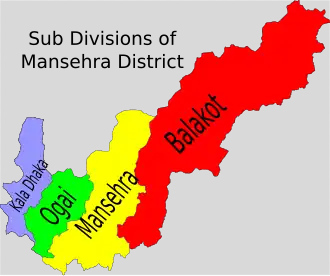
Mansehra District consists of six tehsils, with Tanawal Tehsil separated from the other five in December 2022.[17]
| Tehsil | Name
(Urdu) |
Area
(km²)[18] |
Pop.
(2023) |
Density
(ppl/km²) (2023) |
Literacy rate
(2023)[19] |
Union Councils |
|---|---|---|---|---|---|---|
| Baffa Pakhal | (Urdu: تحصیل بفہ پکھل)[20] | 640 | 460,090 | 718.89 | 60.85% | |
| Bala Kot Tehsil | (Urdu: تحصیل بالاکوٹ) | 2,376 | 310,339 | 130.61 | 67.50% | |
| Darband | (Urdu: تحصیل دربند)[21] | 102 | 51,702 | 506.88 | 50.47% | |
| Mansehra Tehsil | (Urdu: تحصیل مانسہرہ) | 700 | 723,325 | 1,033.32 | 68.70% | |
| Oghi Tehsil | (Urdu: تحصیل اوگی) | 307 | 251,721 | 819.94 | 52.85% | |
| Tanawal Tehsil | (Urdu: تحصیل تناول) | ... | ... | ... | ... |
The Kala Dhaka tehsil was separated as Torghar District in 2011.
Politics
| Member of Provincial Assembly | Party Affiliation | Constituency | Year |
|---|---|---|---|
| Munir Lughmani Swati | Pakistan Tehreek-e-Insaf | PK-36 Mansehra-I | 2024 |
| Babar Saleem Khan Swati | Pakistan Tehreek-e-Insaf | PK-37 Mansehra-II | 2024 |
| Zahid Chanzeb Swati | Pakistan Tehreek-e-Insaf | PK-38 Mansehra-III | 2024 |
| Ikram Ghazi Khan Tanoli | Pakistan Tehreek-e-Insaf | PK-39 Mansehra-IV | 2024 |
| Sardar Shah Jahan Yousaf | Pakistan Muslim League (N) | PK-40 Mansehra-V | 2024 |
Notable people
See also
References
- ^ a b "7th Population and Housing Census - Detailed Results: Table 1" (PDF). www.pbscensus.gov.pk. Pakistan Bureau of Statistics.
- ^ "Literacy rate, enrolments, and out-of-school population by sex and rural/urban, CENSUS-2023, KPK" (PDF).
- ^ "Kolai-Palas made district, Baffa-Pakhal tehsil". 26 August 2017.
- ^ Census report of Mansehra 1998, p. 1.
- ^ Census report of Batagram 1998, p. 18.
- ^ "Population by administrative units 1951-1998" (PDF). Pakistan Bureau of Statistics.
- ^ a b c d e f Nazia, Dr. (2014). GENETIC ANALYSES OF THE MAJOR TRIBES OF ABBOTTABAD AND MANSEHRA DISTRICTS THROUGH DENTAL MORPHOLOGY AND DNA ANALYSES. Department of Genetics Hazara University, Mansehra. p. 9.
Many tribes inhabit the District Mansehra, broadly divisible into the ancient peoples like Gujars and Kohistanis and the recent migrants like Pathans of the area. Awans, Gujars, Swatis, Syeds and Tanolis are the most prominent ethnic groups of the district.
- ^ a b c d e f Nazia, Dr. (2014). GENETIC ANALYSES OF THE MAJOR TRIBES OF ABBOTTABAD AND MANSEHRA DISTRICTS THROUGH DENTAL MORPHOLOGY AND DNA ANALYSES. Department of Genetics Hazara University, Mansehra. pp. 9–10.
In addition the Akhun Khels, Dhunds, Hassanzais, Mughals, Nusrat Khels, Qureshis, Rajputs, Turks and Utmanzais are commonly mentioned ethnic groups of Mansehra (Ghulam, 2003).
- ^ a b "7th Population and Housing Census - Detailed Results: Table 11" (PDF). Pakistan Bureau of Statistics.
- ^ Hallberg & O'Leary 1992, p. 96.
- ^ Hallberg & O'Leary 1992, pp. 112–13, 135The particular variety studied was from the village of Mittikot, six kilometres west of Balakot.
- ^ Anjum & Rehman 2015.
- ^ India Census Commissioner (1941). "Census of India, 1941. Vol. 10, North-West Frontier Province". p. 22. JSTOR saoa.crl.28215543. Retrieved 23 September 2021.
- ^ "Pakistan Census 2017 District-Wise Tables: Mansehra District". Pakistan Bureau of Statistics.
- ^ "7th Population and Housing Census - Detailed Results: Table 9" (PDF). www.pbscensus.gov.pk. Pakistan Bureau of Statistics.
- ^ "› reports". Archived from the original on 8 August 2018. Retrieved 30 September 2018.
- ^ "Tanawal notified as sixth tehsil of Mansehra". Dawn. 26 December 2022. Retrieved 31 December 2022.
- ^ "TABLE 1 : AREA, POPULATION BY SEX, SEX RATIO, POPULATION DENSITY, URBAN POPULATION, HOUSEHOLD SIZE AND ANNUAL GROWTH RATE, CENSUS-2023, KPK" (PDF).
- ^ "LITERACY RATE, ENROLMENT AND OUT OF SCHOOL POPULATION BY SEX AND RURAL/URBAN, CENSUS-2023, KPK" (PDF).
- ^ "Kolai-Palas made district, Baffa-Pakhal tehsil". 26 August 2017.
- ^ "Kolai-Palas made district, Baffa-Pakhal tehsil". 26 August 2017.
- ^ Different from official population figure since it excludes sensitive areas where religion was not asked
Bibliography
- 1998 District census report of Batagram. Census publication. Vol. 18. Islamabad: Population Census Organization, Statistics Division, Government of Pakistan. 1999.
- 1981 District census report of Mansehra. Vol. 23. Islamabad: Population Census Organization, Statistics Division, Government of Pakistan. 1983.
- 1998 District census report of Mansehra. Census publication. Vol. 62. Islamabad: Population Census Organization, Statistics Division, Government of Pakistan. 2000.
- Anjum, Uzma; Rehman, Khawaja (2015). "A First Look at Mankiyali Language: An Endangered Language". Journal of Asian Civilizations. 38 (1): 177–90. ProQuest 1816873650.
- Hallberg, Calinda E.; O'Leary, Clare F. (1992). "Dialect Variation and Multilingualism among Gujars of Pakistan". In O'Leary, Clare F.; Rensch, Calvin R.; Hallberg, Calinda E. (eds.). Hindko and Gujari. Sociolinguistic Survey of Northern Pakistan. Islamabad: National Institute of Pakistan Studies, Quaid-i-Azam University and Summer Institute of Linguistics. pp. 91–196. ISBN 969-8023-13-5.
External links
![]() Media related to Mansehra District at Wikimedia Commons
Media related to Mansehra District at Wikimedia Commons
